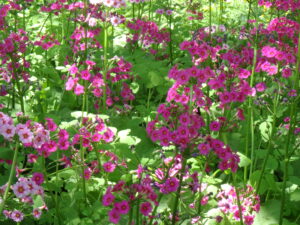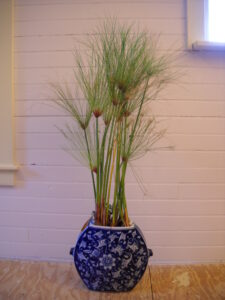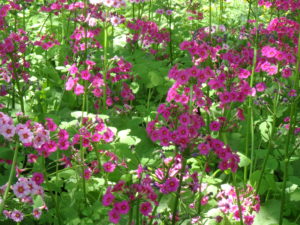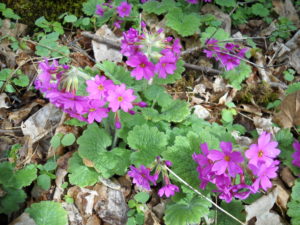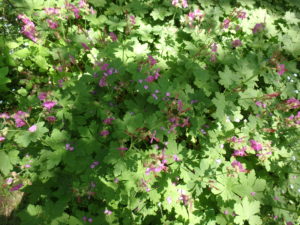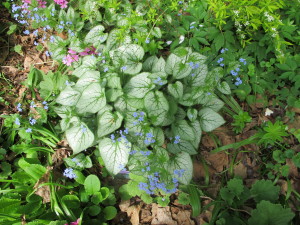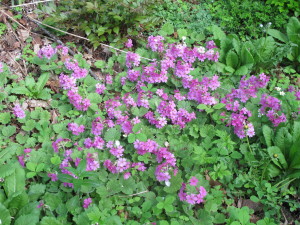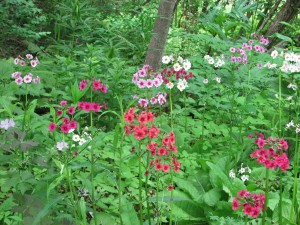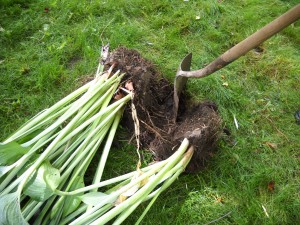How to Prepare for a Garden Party
June is the best time in my garden. I have a primrose garden in the shade of old apple trees with many hundreds of candelabra or Japanese primroses ( Primula japonica) in full bloom. So I want to share this with friends, and recently invited 2 other couples to join Cindy and me for a tour and a chat.
My partner, Cindy, loves cutting sharp edges around flower beds. She uses an edging tool that looks like a half moon on a long handle to shape nice curves to beds. She also uses a tool that you could make: 30 feet of strong masons twine wrapped around 2 nice wooden pegs with points. She pushes a peg into the ground, unwinds some string, and pulls the string tight from the other end. She then pops the second peg into the ground. That gives her a perfectly straight edge if she needs one. Great in the vegetable garden.
Plants in pots are good fillers, too. I have a large blue and white Chinese vase with papyrus growing in it. It has been wintering over in the house for several years, and is a big, handsome plant. I am not above moving it from the deck to the garden to fill in somewhere, or to add interest to a place with no blossoms.
Primroses and Other Great Plants for Shade
If I were to be consigned to life on a remote island, what one flower would I bring along with me? That’s a bit like asking you which child is your favorite, or which piece of music you could listen to for all eternity.
There are so many wonderful flowers, but some years ago I pondered the question and selected the peony ‘Festiva Maxima’. That’s a double white one with a spot of red in the middle, and a fragrance so alluring, I wrote, that it could make one swoon. I acknowledged that Festiva Maxima does have a flaw: rain weighs down the blossoms, and sometimes the flowers break their stems – even if in a peony support cage.
But if you were to ask me today, I would say my favorite flower is the Candelabra or Japanese primrose, Primula japonica. I have a patch of them blooming in the shade of 3 old wild apples in moist, dark soil. I started with just a few plants, but they drop seeds and fill in spaces, overtaking what was once a meager, struggling lawn.
I estimate that right now I have 200 to 250 square feet of primroses in full bloom; in a 3 foot by 3 foot square, I counted about 25 or 30 plants in bloom – so I have more than 500, perhaps even 750. All this in 10 or 15 years, and no work other than a once-a-year weeding of Jewel Weed, which also loves the conditions.
Each plant has a rosette of light green leaves and sends up a flower stalk 12 to 36 inches tall. Flowers ring the stalk in tiers, starting with one tier, and working up to 4 tiers of blossoms on the oldest plants as the season progresses. At each tier there are a dozen small blossoms – or up to 20 – pointing out like bugles. Each blossoms is about an inch across.
The colors vary as they hybridize. My favorites are a deep magenta. At the other end of the spectrum are the whites, though not pure white. Then there are pink, and dark pink ones. All are fabulous. Fragrance? Nothing much. But that would be like expecting a prize poodle to be able to read the newspaper.
The bloom period starts for me in late May and goes through most of June. A month or more with some blossoms. At any given moment a plant might have just one ring of flowers, or up to 3. As the flowers fade and die off, some develop a nice light blue.
Before the candelabra primroses bloomed came another nice one, albeit with no common name, Primula kisoana. This one, unlike the other, will grow in either moist or dry shade. It has lovely pink blossoms that pop up just 6 inches above the fuzzy leaves that are so dense that they keep weeds from appearing. The leaves are 5 inches or so wide with a scalloped edge and a light green color.
One of the greatest things about the Primula kisoana is that it spreads by root. But unlike mint or bee balm, this little beauty does not run over and outcompete other plants. It will politely meet up with the roots of another, and move to the left or right instead of grasping for every inch of soil. Where I have it in dry shade it gets some morning sun, but no afternoon sun.
Another nice plant I have blooming now, and which can act as a ground cover, is bigroot geranium (Geranium macrorrhizum). To avoid confusion I should explain that the bright red or white geraniums popular in window boxes are not geraniums at all, but are in a genus (scientific grouping) known as Pelargonium. Geranium is a genus of hardy perennials.
The bigroot geranium thrives where other perennials may survive, but few love: dry shade with competition from tree roots. Maples and locust are notorious for sucking everything out of the soil, yet I have planted the bigroot geranium under those trees, and had them thrive. Will they grow under hemlocks or pines? No, that’s asking too much.
Bigroot geranium comes in at least three colors: white, pink and dark pink. The leaves are about a foot tall, with the flower stems standing above them at about 20 inches. Their leaves form a dense mass of foliage that most weeds find inhospitable.
On another note, many readers have been complaining that their tomatoes are yellow-leafed and miserable looking. Not to worry. Tomatoes need sunshine, and early June was, for most of us, rainy and cold. They will recover soon.
Plants suck up moisture that contains the minerals they need – but only if the moisture is required to replace water that the plants have given off. They don’t give off much water vapor when it’s chilly and wet, so they can get nitrogen-starved. With heat and sunshine they will recover.
I have set up Adirondack chairs near my primroses and spend at least some time there every day. And even though I’ll never have to pick just one flower to grow, these primroses are a real delight to me.
Read Henry’s twice weekly blog at https://dailyuv.com/
Pondering a Few Perennial Flowers
I aspire to be the Goatsbeard King of Cornish Flat. Maybe I already am. I have several, and no one else I know here grows goatsbeard (Aruncus dioecious). It is one of many flowers I grow that do well in light shade, getting bigger and better every year, and requiring very little of me.
Long ago, decades ago, I bought my first goatsbeard. The plant tag said it would grow in shade, so I foolishly planted it under a Canadian hemlock. It survived, but never bloomed. In terms of sunshine, planting it there was akin to planting it in under a box– virtually no light; additionally, there was lots of root competition from the tree. Then after 10 years I moved it to a place that got nice morning sun, but no afternoon sun. It bloomed and thrived, which taught me to move plants that aren’t thriving.
Goatsbeard blooms in early summer with tall plumes of fluffy white flowers (similar to astilbe flowers) rising above its tall foliage. There are male plants and female plants, though honestly I do not know which is which. (It’s not like puppies, where you just lift up the tail and look). Books tell me the males are showier. The leaves on mine are 3 to 4 feet tall and the clumps get bigger every year. I also have a miniature goatsbeard (A. aethusifolius) that is very nice and compact, and stays just 8 to 15 inches tall and has small white spikes of delicate white flowers that, like its big brother, stand above the foliage.
There are many kinds of shade. Most perennials that grow in shade need some sunshine filtered through canopy of leaves, not an umbrella of shade from evergreens. Morning sun that washes a plant for a few hours early in the day is fine for a shade plant but hot afternoon sun generally is too much. And if a plant is rated for use in the shade, moist soil will usually help it thrive if it gets more direct sun than it would like (otherwise it would dry it out in the sun).
One of my favorite flowers is blooming everywhere right now for me. Forget-me-nots (Myosotis sylvatica) have small 5-petaled light blue flowers on 8- to 15- inch stems, though I have a few with white or pink flowers. They spread by seed, creating waves of color in shade or part shade locations, or even in sunny places. These plants are never a problem: if one pops up somewhere that is designated for another plant, it is easy to remove as its roots are not at all tenacious. It is not clear from the literature if forget-me-nots are annuals, biennials or perennials. If perennials, they are short-lived ones.
A perennial with flowers nearly identical to forget-me-nots is Siberian bugloss, more commonly called Brunnera, which is its Latin name (Brunnera macrophylla). A named cultivar, “Jack Frost’, is one of the most common. The leaves are smaller than the standard species leaves, and are “frosted” with white. The leaves are heart-shaped and very handsome all summer. Any plant with variegated leaves – those that have a lack of green chlorophyll in parts – tend to be smaller and less vigorous, as the white portions do not produce food for the plant.
Primroses are in bloom for me now and are some of my favorites. One with no common name is Primula kisoana, a brilliant magenta flower that spreads nicely by root, but never overpowers other plants. It likes shade and will grow in dry or moist soil. I even have it growing on a rock ledge that only has an inch of soil and it is happy there, too.
Another great primrose is the Japanese primrose (Primula japonica). This is also called the candelabra primrose because it displays 3 or more tiers of umbels (umbrella-shaped clusters of flowers) separated by a few inches of stem. These need moist or even wet soil and do well for me under apple trees in rich, black soil. Most primroses seem to like growing under apples. This one blooms just after P. kisoana, providing continuous color for 4 to 6 weeks between them.
Since early April – and continuing into June – I have had hellebores blooming in dry shade. Also called Lenten rose (Helleborus orientalis), these have handsome evergreen leaves and 2- to 3-inch diameter five-petaled flowers. The flowers are good looking even when past their prime (like many gardeners I know). I have them growing in dry soil in a shady location that gets a little morning sun. If you haven’t tried them, you should. Their colors range from white to deep maroon, and hybrids now come in doubles (with extra petals). ‘Peppermint Ice’ is a very nice double hybrid.
In that same bed with the hellebores I have some very nice anemones, one called Anemone nemorosa. Not all anemones are nice, however. There is a common one often found at plant sales called Canadian or meadow anemone (Anemone canadensis). It has a pretty white flower, but spreads too quickly and cannot be easily removed or controlled. A thug. But A. nemorosa stays in nice clumps with 1-inch lavender or white blossoms on 6 inch stems. Fall blooming Japanese anemones (A. x hybrida) are wonderful, too.
An easy shade-blooming ground cover is spotted deadnettle (Lamium maculatum). It has small pink-mauve flowers on square stems, but the flowers are not showy. It will spread quickly. Its foliage is 6- to 8-inches tall and each leaf has a white stripe up the middle.
Shade is too often neglected by gardeners. There are so many flowers that will thrive there, you really must try some new ones this year. Head for your local family-owned nursery and see what grabs your fancy. And who knows? Maybe you’ll come home with goats (beard)!
Henry Homeyer is a gardening consultant and author. His web site is www.Gardening-Guy.com.
Saving Money in the Flower Garden
My house sits on a couple of acres, most of which is growing something. There is a big vegetable garden, some trees, berry bushes and decorative shrubs, a little lawn and lots of flowers. I could spend a fortune, I suppose, if I bought flowers for every square foot of flowerbed that I have. Over the years, however, I have learned how to transplant small plants that started on their own from seed – “volunteers” – and how to divide existing perennials.
Let’s start with the volunteer plants. The first thing one must do is learn to recognize the young seedlings – and not pull them as weeds. I do this mainly by the color and texture of the leaves, but shape is important, too. And of course, you can’t use bark mulch in the flower beds if you want volunteers. I grow perennials close together so that they shade out weeds, and try to pull any weeds that do grow before the go to seed.
Twenty years ago a neighbor pulled up in front of my house and handed me a cardboard box with 8 candelabra primroses (Primula japonica). I accepted them with pleasure, and went directly to a good reference book to find out what they needed: rich soil, light shade, consistent moisture. I had those conditions under a small grove of wild apple trees, and planted them there.
Now I have hundreds of candelabra primroses and many other kinds. Once I realized that one primrose would grow there, I tried other species, and all but one (P. vialii) have done well there – and spread. Most spread by seed, and one (P. kisona) by root, like a groundcover. I regularly dig primroses and move them or give them to friends.
Giving excess plants to friends, especially lesser known varieties, is a great way to save money. I find that if you give a person a nice clump of flowers, you are most certainly going to go home with 2 or 3 new plants for your own garden.
Dividing plants is easy, once you get the hang of it. But you have to know what kind of root each perennial has, and that generally means some experimentation. The only book I have found that describes dividing for most common perennials is The Well-Tended Perennial Garden: Planting & Pruning Techniques by Tracy DiSabato-Aust. That’s a book that should be in every gardener’s library because it tells you how to prune, deadhead, get to re-bloom, divide and more. It’s in hardback at $34.95 (Timber Press, 2006) and worth every penny.
It is best to divide most perennials in the spring when the foliage is just 3-6 inches tall. Tough characters like hostas and daylilies can be done anytime, though preferably on a cool cloudy day if doing so now. I recently divided a few hostas and took off a section from a large bugbane or snakeroot (Cimicifuga ramosa), and none showed signs of stress.
You can cut out a section of a large hosta or daylily by cutting out a wedge with a spade or even a long knife. I sometimes use a serrated root knife I got from Lee Valley Tools. Tracy DiSabato-Aust prefers a non-serrated knife, so I guess either will work just fine. Get down on your hands and knees and try to see natural division points before you cut.
Alternatively, you can dig up a plant, place it on the ground and then use 2 spading forks to separate it. Just insert them into the middle of the clump, back-to-back, and work the forks back and forth. It’s a lot of work for a big clump of daylilies. I prefer just to cut up a clump with a sharp spade. The spade lets me stand on it with all my weight to slice through the tough roots. I once divided a 4-foot wide clump of Joe Pye weed (Eupatorium maculatum) and ended up using a pick ax to whack it apart. Not a pretty sight, but I was determined to remove and divide it.
Groundcovers send out roots and can be divided anytime. Just dig up a plant, sever the root from the mother plant, and move it to a new location. Easy.
Some plants have fleshy taproots that are easily broken, and these are not good candidates for division. Peonies, Oriental poppies, bleeding heart and pink mallow fit in that category. They should be divided in the fall –though little seedlings move easily, spring or fall. Siberian iris should be divided in fall.
Some plants go downhill and become less vigorous if they are not divided on a regular basis. Have you lost a nice Shasta daisy? If so, please try again – but divide it every 3 years. That allows you to add compost and slow-release organic fertilizer to the soil, which rejuvenates the plants.
The easiest, least expensive method for getting more flowers is just to save seeds and plant them. I plant when the seeds are ripe, just scratching them in where I want more plants next year. I do this with Jack-in-the-pulpit, annual poppies, foxgloves and rose campion, and they generally reward me handsomely.
So don’t spend a fortune. Divide, trade with friends, start things by seed. In no time you’ll have all the plants you need – even if not all the plants you want.
Henry Homeyer is the author of 4 gardening books. His Web site is www.Gardening-Guy.com.



